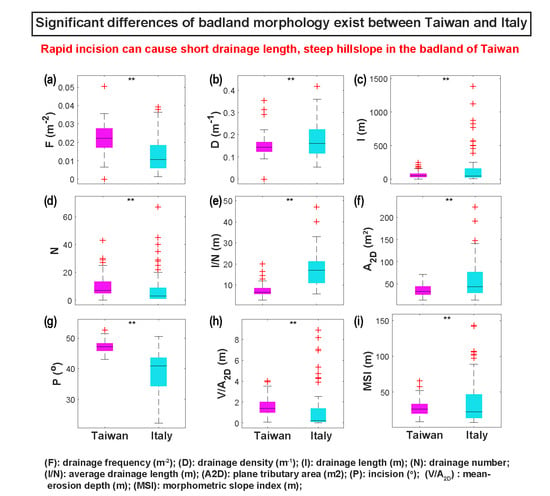Badland Erosion and Its Morphometric Features in the Tropical Monsoon Area
Abstract
1. Introduction
2. Materials and Methods
2.1. Study Area
2.2. DEMs Created from UAV Surveys
2.3. DEM of Difference (DoD)
2.4. Parameter Extraction and Calculation of MSI
3. Results
3.1. DoD Uncertainty Estimation
3.2. Morphometric Slope Index (MSI)
3.3. Distribution of Hillslope Erosion
4. Discussion
4.1. The Effect of Rapid Incision on Morphology of Hillslopes in Badlands
4.2. Distinct Erosion Patterns in the Badlands Landscapes of Taiwan
4.3. Benefitting from the UAV-Driven High-Resolution Topography in Application of MSI
5. Conclusions
Author Contributions
Funding
Acknowledgments
Conflicts of Interest
References
- Valentin, C.; Poesen, J.; Li, Y. Gully erosion: Impacts, factors and control. Catena 2005, 63, 132–153. [Google Scholar] [CrossRef]
- Gomez, B.; Banbury, K.; Marden, M.; Trustrum, N.A.; Peacock, D.H.; Hoskin, P.J. Gully erosion and sediment production: Te Weraroa Stream, New Zealand. Water Resour. Res. 2003, 39. [Google Scholar] [CrossRef]
- Castaldi, F.; Chiocchini, U. Effects of land use changes on badland erosion in clayey drainage basins, Radicofani, Central Italy. Geomorphology 2012, 169, 98–108. [Google Scholar] [CrossRef]
- Mongil-Manso, J.; Navarro-Hevia, J.; Díaz-Gutiérrez, V.; Cruz-Alonso, V.; Ramos-Díez, I. Badlands forest restoration in Central Spain after 50 years under a Mediterranean-continental climate. Ecol. Eng. 2016, 97, 313–326. [Google Scholar] [CrossRef]
- Lee, D.-H.; Lin, H.-M.; Wu, J.-H. The Basic Properties Of Mudstone Slope In Southwestern Taiwan. J. GeoEng. 2007, 2, 15. [Google Scholar]
- Higuchi, K.; Chigira, M.; Lee, D.-H. High rates of erosion and rapid weathering in a Plio-Pleistocene mudstone badland, Taiwan. Catena 2013, 106, 68–82. [Google Scholar] [CrossRef]
- Kao, S.-J.I.; Milliman, J. Water and Sediment Discharge from Small Mountainous Rivers, Taiwan: The Roles of Lithology, Episodic Events, and Human Activities. J. Geol. 2008, 116, 431–448. [Google Scholar] [CrossRef]
- Benito, G.; Gutie’rrez, M.; Sancho, C. Erosion rates in badland areas of the central Ebro Basin (NE-Spain). Catena 1992, 19, 269–286. [Google Scholar] [CrossRef]
- Clarke, M.L.; Rendell, H.M. Process–form relationships in Southern Italian badlands: Erosion rates and implications for landform evolution. Earth Surf. Process. Landf. 2006, 31, 15–29. [Google Scholar] [CrossRef]
- Sirvent, J.; Desir, G.; Gutiérrez, M.; Sancho, C.; Benito, G. Erosion rates in badland areas recorded by collectors, erosion pins and profilometer techniques (Ebro Basin, NE-Spain). Geomorphology 1997, 18, 61–75. [Google Scholar] [CrossRef]
- Neugirg, F.; Stark, M.; Kaiser, A.; Vlacilova, M.; Della Seta, M.; Vergari, F.; Schmidt, J.; Becht, M.; Haas, F. Erosion processes in calanchi in the Upper Orcia Valley, Southern Tuscany, Italy based on multitemporal high-resolution terrestrial LiDAR and UAV surveys. Geomorphology 2016, 269, 8–22. [Google Scholar] [CrossRef]
- Eltner, A.; Baumgart, P.; Maas, H.-G.; Faust, D. Multi-temporal UAV data for automatic measurement of rill and interrill erosion on loess soil. Earth Surf. Process. Landf. 2015, 40, 741–755. [Google Scholar] [CrossRef]
- Fonstad, M.; Dietrich, J.; Courville, B.; Jensen, J.; Carbonneau, P. Topographic Structure from Motion: A new development in photogrammetric measurement. Earth Surf. Process. Landf. 2013, 38, 421–430. [Google Scholar] [CrossRef]
- Hugenholtz, C.H.; Whitehead, K.; Brown, O.W.; Barchyn, T.E.; Moorman, B.J.; LeClair, A.; Riddell, K.; Hamilton, T. Geomorphological mapping with a small unmanned aircraft system (sUAS): Feature detection and accuracy assessment of a photogrammetrically-derived digital terrain model. Geomorphology 2013, 194, 16–24. [Google Scholar] [CrossRef]
- Bianchini, S.; Del Soldato, M.; Solari, L.; Nolesini, T.; Pratesi, F.; Moretti, S. Badland susceptibility assessment in Volterra municipality (Tuscany, Italy) by means of GIS and statistical analysis. Environ. Earth Sci. 2016, 75, 889. [Google Scholar] [CrossRef]
- Del Soldato, M.; Riquelme, A.; Tomás, R.; De Vita, P.; Moretti, S. Application of structure from motion photogrammetry to multi-temporal geomorphological analyses: Case studies from Italy and Spain. Geogr. Fis. Din. Quat. 2018, 41, 97–102. [Google Scholar] [CrossRef]
- Afana, A.; Sole-Benet, A.; Perezc, J.L. Determination of Soil Erosion Using Laser Scanners. In Proceedings of the 19th World Congress of Soil Science, Soil Solutions for a Changing World, Brisbane, Australia, 1–6 August 2010; pp. 39–42. [Google Scholar]
- Milan, D.; Heritage, G.; Hetherington, D. Application of a 3D laser scanner in the assessment of erosion and deposition volumes in a proglacial river. Earth Surf. Process. Landf. 2007, 32, 1657–1674. [Google Scholar] [CrossRef]
- Tarolli, P. High-resolution topography for understanding Earth surface processes: Opportunities and challenges. Geomorphology 2014, 216, 295–312. [Google Scholar] [CrossRef]
- Cheng, Y.-C.; Yang, C.-J.; Lin, J.-C. Application for Terrestrial LiDAR on Mudstone Erosion Caused by Typhoons. Remote Sens. 2019, 11, 2425. [Google Scholar] [CrossRef]
- Westoby, M.J.; Brasington, J.; Glasser, N.F.; Hambrey, M.J.; Reynolds, J.M. ‘Structure-from-Motion’ photogrammetry: A low-cost, effective tool for geoscience applications. Geomorphology 2012, 179, 300–314. [Google Scholar] [CrossRef]
- Adams, S.; Friedland, C. A Survey of Unmanned Aerial Vehicle (UAV) Usage for Imagery Collection in Disaster Research and Management. In Proceedings of the 9th International Conference on Geoinformation for Disaster Management (Gi4DM), Hanoi, Vietnam, 9–11 December 2013. [Google Scholar]
- Pajares, G. Overview and Current Status of Remote Sensing Applications Based on Unmanned Aerial Vehicles (UAVs). Photogramm. Eng. Remote Sens. 2015, 81, 281–329. [Google Scholar] [CrossRef]
- Gomez, C.; Purdie, H. UAV-based Photogrammetry and Geocomputing for Hazards and Disaster Risk Monitoring—A Review. Geoenviron. Disasters 2016, 3, 23. [Google Scholar] [CrossRef]
- Angster, S.; Wesnousky, S.; Huang, W.l.; Kent, G.; Nakata, T.; Goto, H. Application of UAV Photography to Refining the Slip Rate on the Pyramid Lake Fault Zone, Nevada. Bull. Seismol. Soc. Am. 2016, 106, 785–798. [Google Scholar] [CrossRef]
- Bi, H.; Zheng, W.; Ren, Z.; Zeng, J.; Yu, J. Using an unmanned aerial vehicle for topography mapping of the fault zone based on structure from motion photogrammetry. Int. J. Remote Sens. 2017, 38, 2495–2510. [Google Scholar] [CrossRef]
- Shi, X.; Weldon, R.; Liu-Zeng, J.; Wang, Y.; Weldon, E.; Sieh, K.; Li, Z.; Zhang, J.; Yao, W.; Li, Z. Limit on slip rate and timing of recent seismic ground-ruptures on the Jinghong fault, SE of the eastern Himalayan syntaxis. Tectonophysics 2018, 734, 148–166. [Google Scholar] [CrossRef]
- Tamminga, A.; Hugenholtz, C.; Eaton, B.; Lapointe, M. Hyperspatial Remote Sensing of Channel Reach Morphology and Hydraulic Fish Habitat Using an Unmanned Aerial Vehicle (UAV): A First Assessment in the Context of River Research and Management. River Res. Appl. 2015, 31, 379–391. [Google Scholar] [CrossRef]
- Cook, K.L. An evaluation of the effectiveness of low-cost UAVs and structure from motion for geomorphic change detection. Geomorphology 2017, 278, 195–208. [Google Scholar] [CrossRef]
- Langhammer, J.; Vacková, T. Detection and Mapping of the Geomorphic Effects of Flooding Using UAV Photogrammetry. Pure Appl. Geophys. 2018, 175, 3223–3245. [Google Scholar] [CrossRef]
- Niethammer, U.; James, M.R.; Rothmund, S.; Travelletti, J.; Joswig, M. UAV-based remote sensing of the Super-Sauze landslide: Evaluation and results. Eng. Geol. 2012, 128, 2–11. [Google Scholar] [CrossRef]
- Lucieer, A.; Jong, S.M.d.; Turner, D. Mapping landslide displacements using Structure from Motion (SfM) and image correlation of multi-temporal UAV photography. Prog. Phys. Geogr. Earth Environ. 2014, 38, 97–116. [Google Scholar] [CrossRef]
- Turner, D.; Lucieer, A.; De Jong, S.M. Time Series Analysis of Landslide Dynamics Using an Unmanned Aerial Vehicle (UAV). Remote Sens. 2015, 7, 1736–1757. [Google Scholar] [CrossRef]
- Saito, H.; Uchiyama, S.; Hayakawa, Y.S.; Obanawa, H. Landslides triggered by an earthquake and heavy rainfalls at Aso volcano, Japan, detected by UAS and SfM-MVS photogrammetry. Prog. Earth Planet. Sci. 2018, 5, 15. [Google Scholar] [CrossRef]
- Rossi, G.; Tanteri, L.; Tofani, V.; Vannocci, P.; Moretti, S.; Casagli, N. Multitemporal UAV surveys for landslide mapping and characterization. Landslides 2018, 15, 1045–1052. [Google Scholar] [CrossRef]
- Buccolini, M.; Coco, L.; Cappadonia, C.; Rotigliano, E. Relationships between a new slope morphometric index and calanchi erosion in northern Sicily, Italy. Geomorphology 2012, 149, 41–48. [Google Scholar] [CrossRef]
- Buccolini, M.; Coco, L. The role of the hillside in determining the morphometric characteristics of “calanchi”: The example of Adriatic central Italy. Geomorphology 2010, 123, 200–210. [Google Scholar] [CrossRef]
- Buccolini, M.; Coco, L. MSI (morphometric slope index) for analyzing activation and evolution of calanchi in Italy. Geomorphology 2013, 191, 142–149. [Google Scholar] [CrossRef]
- Buccolini, M.; Materazzi, M.; Aringoli, D.; Gentili, B.; Pambianchi, G.; Scarciglia, F. Late Quaternary catchment evolution and erosion rates in the Tyrrhenian side of central Italy. Geomorphology 2014, 204, 21–30. [Google Scholar] [CrossRef]
- Yen, F.-S. Study on stability process of natural rock slope in mudstone slope land in southwestern Taiwan. Natl. Sci. Counc. Exec. Yuan Disaster Prev. Sci. Technol. Res. Rep. 1992, 80, 1–33. [Google Scholar]
- Yen, F.-S.; Chen, J.-K. The relationships between the morphology and the weathering-erosion behavior of mudstone slopes in the southwestern Taiwan. Natl. Sci. Counc. Exec. Yuan Disaster Prev. Sci. Technol. Res. Rep. 1989, 78, 1–36. [Google Scholar]
- Central Geological Survey, Ministry of Economic Affairs (MOEA). Geologic Map of Taiwan: Qishan Sheet, Scale 1:50,000; Central Geological Survey: New Taipei City, Taiwan, 2013.
- SenseFly. eBee Classic Specification. Available online: https://www.sensefly.com/drone/ebee-mapping-drone/ (accessed on 17 November 2019).
- Wheaton, J.M.; Brasington, J.; Darby, S.E.; Sear, D.A. Accounting for uncertainty in DEMs from repeat topographic surveys: Improved sediment budgets. Earth Surf. Process. Landf. 2010, 35, 136–156. [Google Scholar] [CrossRef]
- Williams, R.D. DEMs of Difference. In Geomorphological Techniques (Online Edition); Cook, S.J., Clarke, L.E., Nield, J.M., Eds.; British Society for Geomorphology: London, UK, 2012; pp. 1–17. [Google Scholar]
- Hsieh, M.-L.; Knuepfer, P.L.K. Middle–late Holocene river terraces in the Erhjen River Basin, southwestern Taiwan—Implications of river response to climate change and active tectonic uplift. Geomorphology 2001, 38, 337–372. [Google Scholar] [CrossRef]
- Seta, D.M.; Monte, M.; Fredi, P.; Lupia Palmieri, E. Gully erosion in central Italy: Denudation rate estimation and morphoevolution of Calanchi and Biancane badlands. In Proceedings of the IV International Symposium on Gully Erosion, Pamplona, Spain, 17–19 September 2007; Public University of Navarra: Pamplona, Spain, 2007. [Google Scholar]
- Sirio, C.; Galiano, M.; Roma, M.; Salvatore, M.C. Morphological analysis and erosion rate evaluation in badlands of Radicofani area (Southern Tuscany—Italy). Catena 2008, 74, 87–97. [Google Scholar] [CrossRef]
- Densmore, A.L.; Hovius, N. Topographic fingerprints of bedrock landslides. Geology 2000, 28, 371–374. [Google Scholar] [CrossRef]
- Meunier, P.; Hovius, N.; Haines, J. Topographic site effects and the location of earthquake induced landslides. Earth Planet. Sci. Lett. 2008, 275, 221–232. [Google Scholar] [CrossRef]
- Huang, J.-C.; Milliman, J.D.; Lee, T.-Y.; Chen, Y.-C.; Lee, J.-F.; Liu, C.-C.; Lin, J.-C.; Kao, S.-J. Terrain attributes of earthquake- and rainstorm-induced landslides in orogenic mountain Belt, Taiwan. Earth Surf. Process. Landf. 2017, 42, 1549–1559. [Google Scholar] [CrossRef]
- Kääb, A. Monitoring high-mountain terrain deformation from repeated air- and spaceborne optical data: Examples using digital aerial imagery and ASTER data. ISPRS J. Photogramm. Remote Sens. 2002, 57, 39–52. [Google Scholar] [CrossRef]
- Liu, J.G.; Mason, P.; Clerici, N.; Chen, S.; Davis, A.; Miao, F.; Deng, H.; Liang, L. Landslide hazard assessment in the Three Gorges area of the Yangtze River using ASTER imagery: Zigui-Badong. Geomorphology 2004, 61, 171–187. [Google Scholar] [CrossRef]
- Nichol, J.E.; Shaker, A.; Wong, M.-S. Application of high-resolution stereo satellite images to detailed landslide hazard assessment. Geomorphology 2006, 76, 68–75. [Google Scholar] [CrossRef]
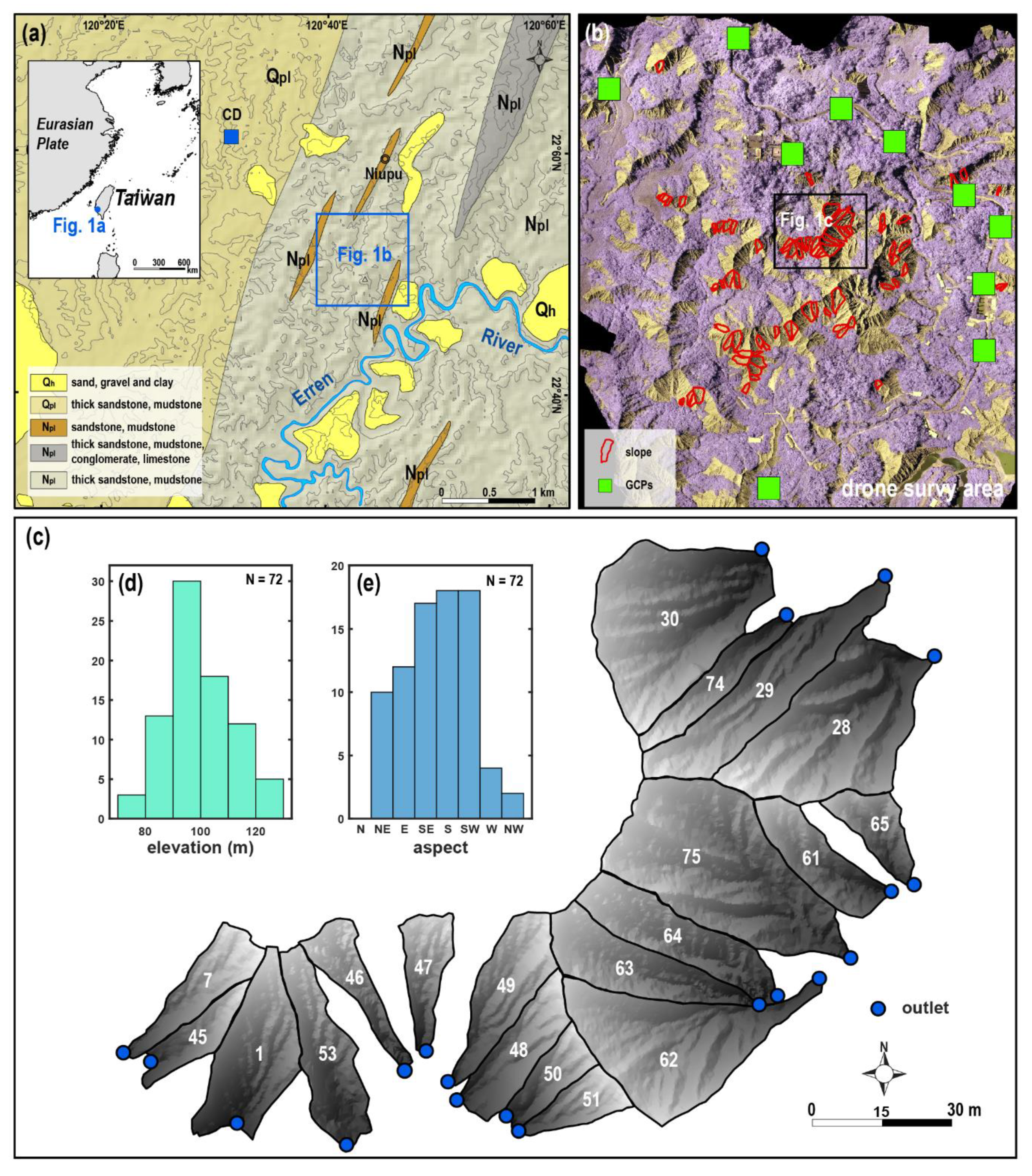
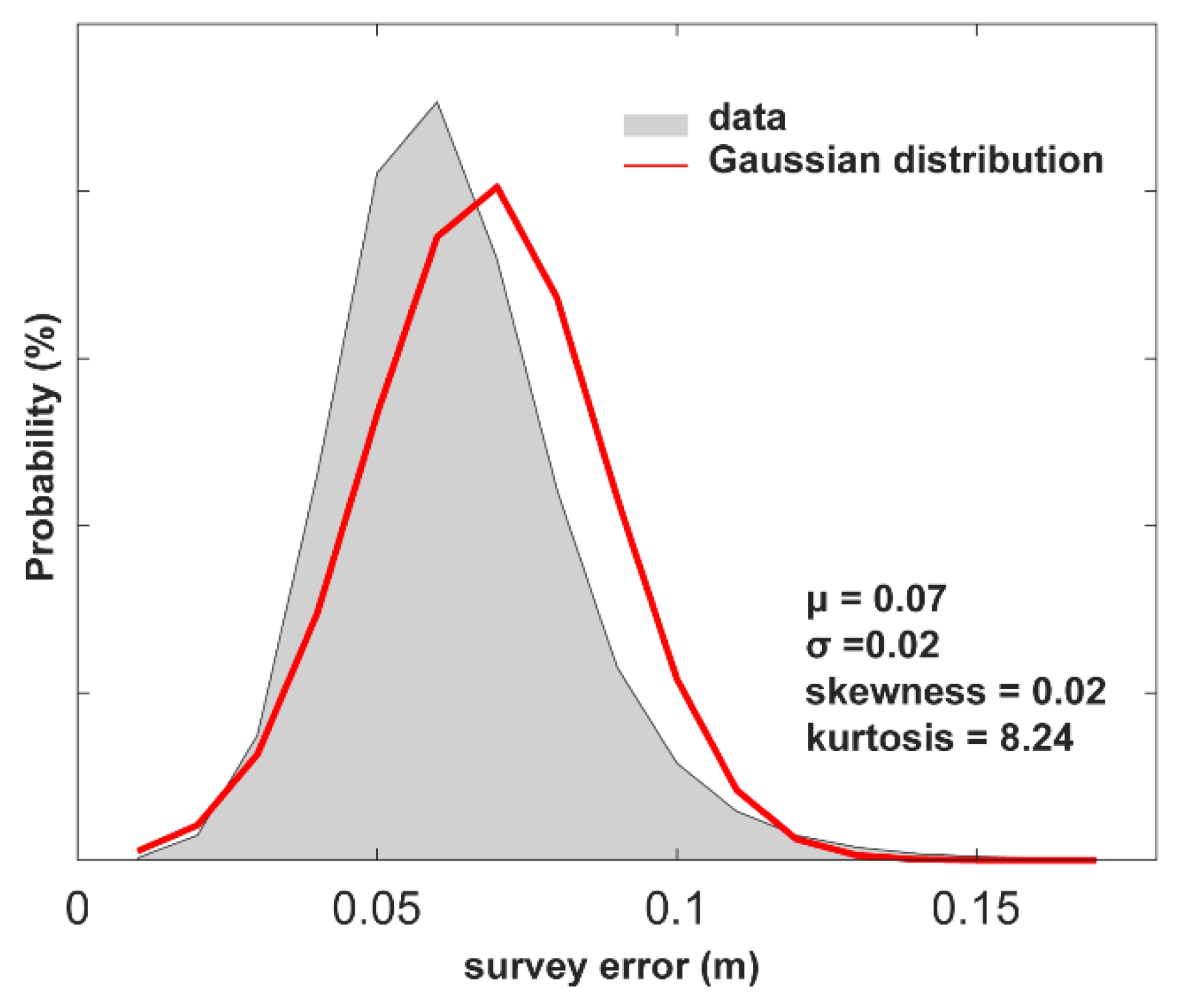
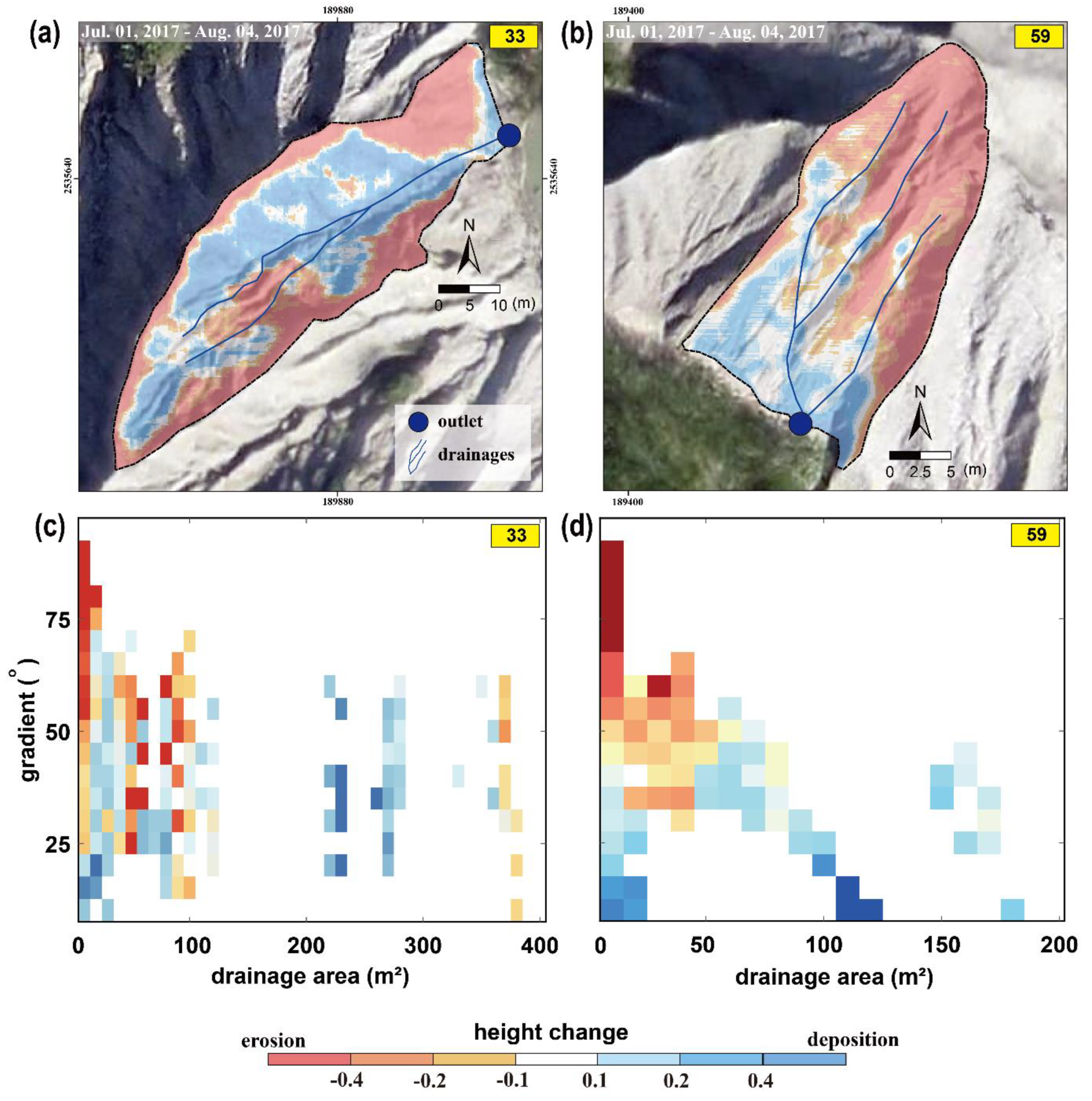
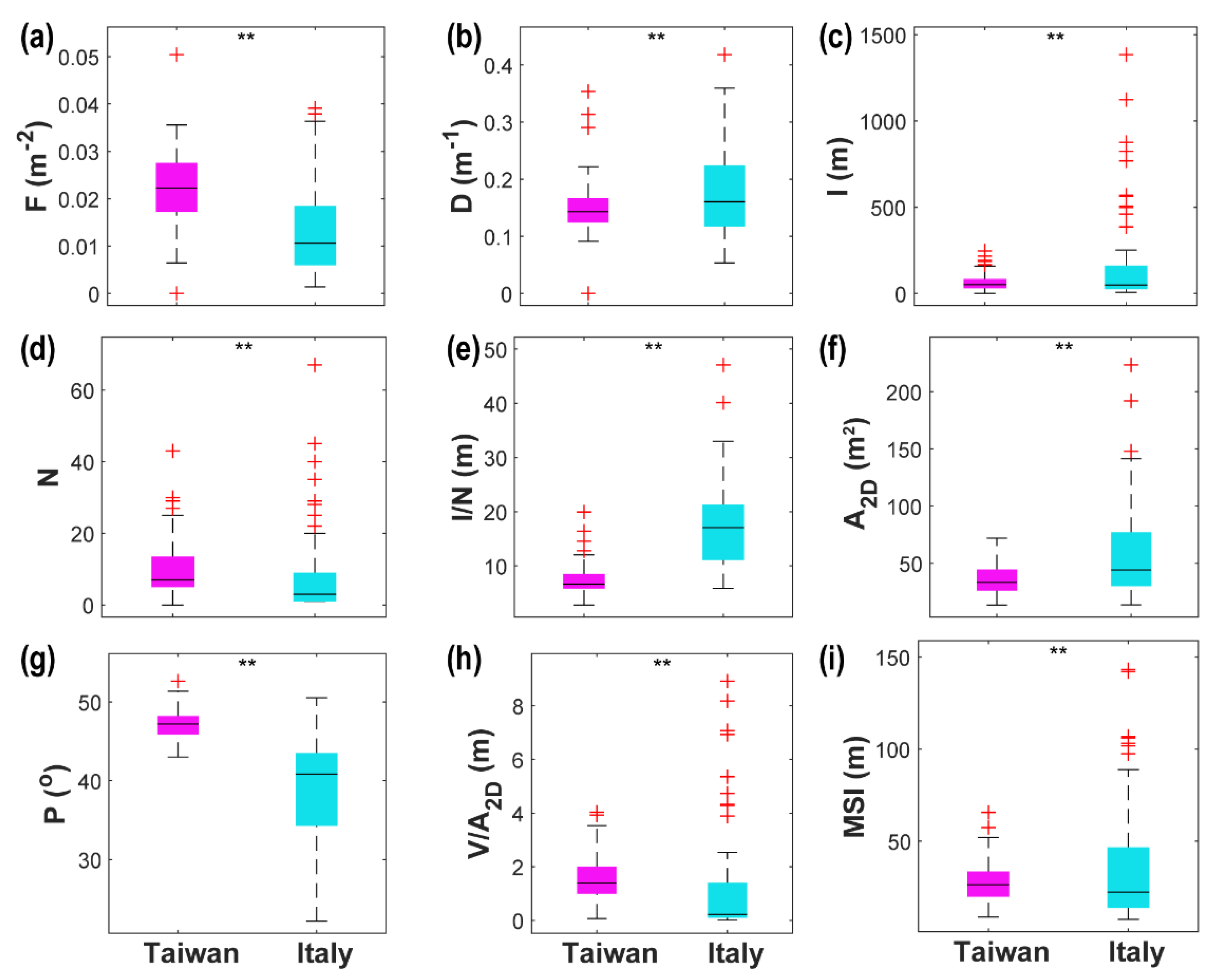
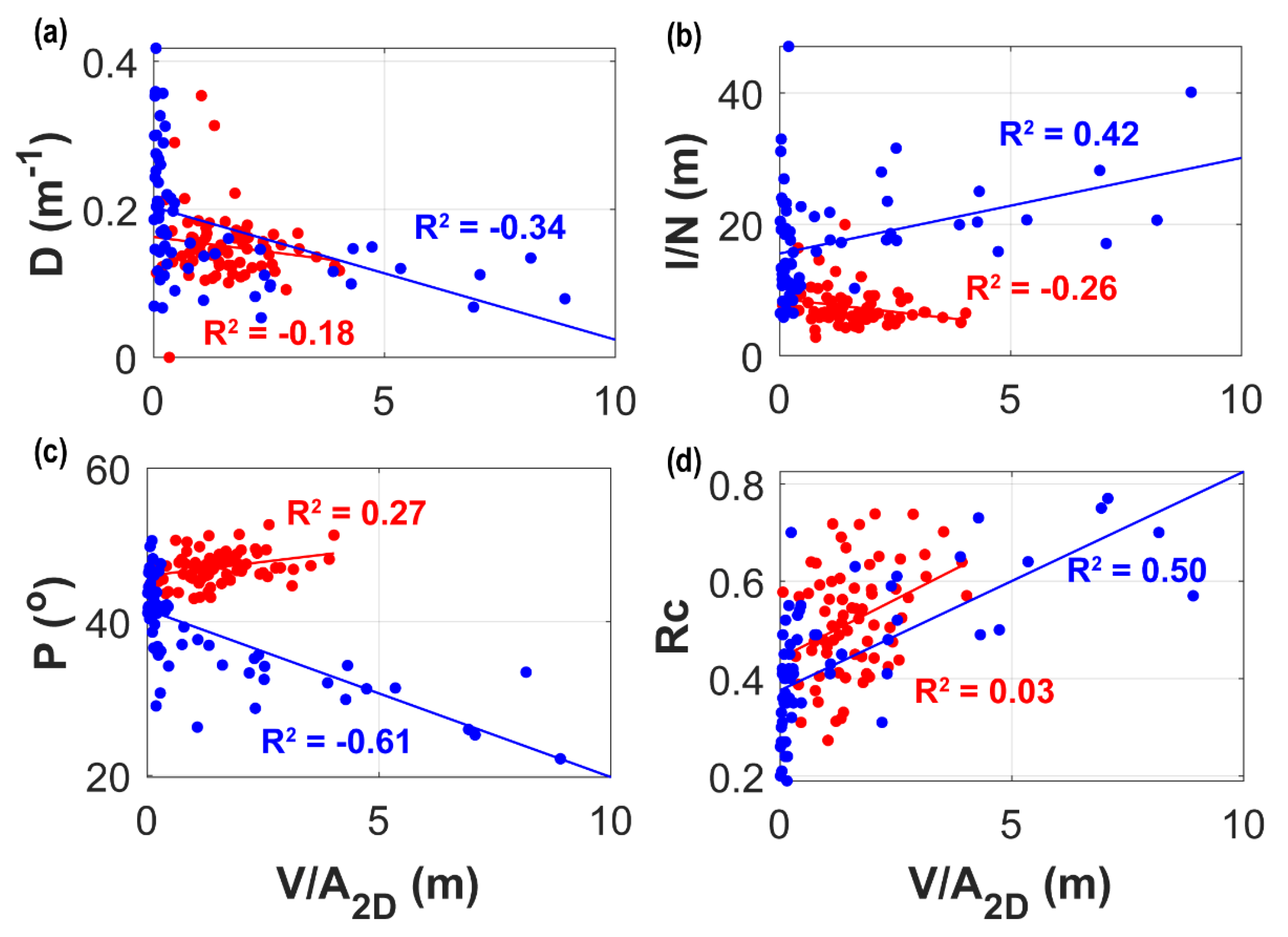
| Date | Rainfall in This Period (mm) | Number of Images Obtained | Flight Height (m) | GSD (cm/pixel) | RMS * of Horizontal Errors (m) | RMS of Vertical Errors (m) | Point Cloud Density (pts/m2) |
|---|---|---|---|---|---|---|---|
| 2017/07/01 | 748.1 | 111 | 330 | 11 | 0.01 ± 0.01 | 0.03 ± 0.04 | 159 |
| 2017/08/04 | 124 | 320 | 11 | 0.01 ± 0.02 | 0.04 ± 0.03 | 145 |
| Slope ID | F | D | L | N | l/N | L | P | Rc | V | V/A | MSI |
|---|---|---|---|---|---|---|---|---|---|---|---|
| 1 | 0.03 | 0.16 | 110.59 | 19 | 5.82 | 52.90 | 48.92 | 0.50 | 1676.98 | 2.37 | 40.65 |
| 2 | 0.03 | 0.16 | 81.14 | 14 | 5.80 | 37.56 | 47.26 | 0.56 | 550.27 | 1.06 | 31.15 |
| 3 | 0.01 | 0.18 | 25.62 | 2 | 12.81 | 23.62 | 46.26 | 0.31 | 170.51 | 1.21 | 10.67 |
| 4 | 0.03 | 0.17 | 190.76 | 30 | 6.36 | 32.06 | 43.19 | 0.72 | 1239.45 | 1.14 | 31.55 |
| 5 | 0.03 | 0.17 | 158.71 | 24 | 6.61 | 34.58 | 44.67 | 0.65 | 2956.57 | 3.12 | 31.84 |
| 6 | 0.03 | 0.15 | 83.81 | 17 | 4.93 | 48.76 | 46.20 | 0.48 | 1386.21 | 2.43 | 33.48 |
| 7 | 0.03 | 0.21 | 84.87 | 11 | 7.72 | 39.83 | 45.25 | 0.41 | 97.39 | 0.24 | 23.41 |
| 8 | 0.03 | 0.18 | 77.78 | 13 | 5.98 | 39.66 | 48.76 | 0.55 | 657.67 | 1.55 | 32.80 |
| 9 | 0.02 | 0.15 | 112.01 | 17 | 6.59 | 43.68 | 46.81 | 0.61 | 2406.42 | 3.15 | 38.91 |
| 10 | 0.03 | 0.12 | 62.64 | 14 | 4.47 | 46.01 | 47.45 | 0.45 | 814.64 | 1.62 | 30.60 |
| 11 | 0.05 | 0.14 | 25.20 | 9 | 2.80 | 22.44 | 46.19 | 0.64 | 138.62 | 0.78 | 20.64 |
| 12 | 0.02 | 0.14 | 8.84 | 1 | 8.84 | 19.29 | 46.82 | 0.47 | 63.78 | 1.02 | 13.15 |
| 13 | 0.03 | 0.18 | 33.44 | 5 | 6.69 | 32.20 | 48.12 | 0.48 | 135.41 | 0.74 | 22.96 |
| 14 | 0.02 | 0.14 | 51.41 | 6 | 8.57 | 33.22 | 44.45 | 0.53 | 492.33 | 1.36 | 24.66 |
| 15 | 0.03 | 0.11 | 11.63 | 3 | 3.88 | 25.84 | 47.86 | 0.38 | 79.93 | 0.76 | 14.45 |
| 16 | 0.01 | 0.11 | 21.81 | 3 | 7.27 | 29.04 | 48.29 | 0.48 | 378.16 | 1.88 | 20.80 |
| 17 | 0.01 | 0.13 | 48.12 | 5 | 9.62 | 49.82 | 49.36 | 0.44 | 982.22 | 2.57 | 33.51 |
| 18 | 0.02 | 0.12 | 45.48 | 7 | 6.50 | 43.79 | 49.17 | 0.52 | 623.55 | 1.70 | 35.03 |
| 19 | 0.02 | 0.14 | 145.07 | 25 | 5.80 | 47.74 | 47.29 | 0.70 | 3767.89 | 3.53 | 49.36 |
| 20 | 0.03 | 0.16 | 17.44 | 3 | 5.81 | 23.54 | 50.36 | 0.59 | 92.44 | 0.86 | 21.86 |
| 21 | 0.02 | 0.15 | 166.73 | 19 | 8.78 | 56.04 | 47.00 | 0.57 | 3034.36 | 2.77 | 46.52 |
| 22 | 0.02 | 0.21 | 135.55 | 13 | 10.43 | 34.36 | 43.78 | 0.64 | 424.07 | 0.67 | 30.43 |
| 23 | 0.03 | 0.17 | 142.03 | 25 | 5.68 | 40.42 | 45.87 | 0.65 | 2219.02 | 2.60 | 37.47 |
| 24 | 0.02 | 0.14 | 54.26 | 9 | 6.03 | 26.13 | 46.14 | 0.69 | 498.76 | 1.32 | 26.04 |
| 25 | 0.03 | 0.15 | 86.27 | 15 | 5.75 | 34.33 | 46.07 | 0.61 | 764.64 | 1.29 | 29.97 |
| 26 | 0.03 | 0.14 | 48.35 | 10 | 4.84 | 32.94 | 46.37 | 0.58 | 871.05 | 2.50 | 27.88 |
| 27 | 0.03 | 0.35 | 42.67 | 4 | 10.67 | 27.45 | 47.69 | 0.27 | 124.88 | 1.03 | 11.14 |
| 28 | 0.02 | 0.13 | 185.82 | 27 | 6.88 | 49.60 | 47.25 | 0.57 | 592.74 | 0.41 | 41.52 |
| 30 | 0.02 | 0.16 | 246.35 | 27 | 9.12 | 47.92 | 47.01 | 0.74 | 3117.43 | 2.05 | 51.88 |
| 31 | 0.02 | 0.14 | 52.14 | 7 | 7.45 | 26.08 | 43.17 | 0.33 | 504.93 | 1.37 | 11.83 |
| 32 | 0.03 | 0.17 | 65.31 | 11 | 5.94 | 31.61 | 46.66 | 0.63 | 749.07 | 1.93 | 29.21 |
| 33 | 0.01 | 0.14 | 49.32 | 5 | 9.86 | 32.55 | 44.60 | 0.45 | 623.54 | 1.73 | 20.56 |
| 35 | 0.02 | 0.16 | 24.86 | 3 | 8.29 | 25.09 | 49.76 | 0.51 | 172.95 | 1.13 | 19.74 |
| 36 | 0.01 | 0.13 | 14.56 | 1 | 14.56 | 22.76 | 49.14 | 0.40 | 94.93 | 0.85 | 14.08 |
| 37 | 0.01 | 0.11 | 53.98 | 7 | 7.71 | 28.17 | 44.92 | 0.58 | 29.87 | 0.06 | 22.97 |
| 38 | 0.01 | 0.11 | 55.53 | 7 | 7.93 | 31.70 | 47.45 | 0.58 | 982.93 | 1.97 | 27.35 |
| 39 | 0.03 | 0.15 | 29.69 | 5 | 5.94 | 21.81 | 43.02 | 0.45 | 197.19 | 1.01 | 13.50 |
| 40 | 0.03 | 0.12 | 51.03 | 12 | 4.25 | 27.24 | 46.85 | 0.67 | 585.24 | 1.42 | 26.64 |
| 41 | 0.03 | 0.11 | 29.77 | 7 | 4.25 | 22.36 | 46.14 | 0.72 | 452.40 | 1.71 | 23.12 |
| 42 | 0.03 | 0.14 | 40.51 | 8 | 5.06 | 23.21 | 44.96 | 0.59 | 460.12 | 1.60 | 19.21 |
| 45 | 0.01 | 0.12 | 32.11 | 3 | 10.70 | 34.93 | 47.44 | 0.41 | 48.38 | 0.18 | 21.18 |
| 46 | 0.02 | 0.16 | 51.14 | 5 | 10.23 | 42.46 | 47.53 | 0.35 | 259.00 | 0.82 | 22.12 |
| 47 | 0.02 | 0.15 | 45.81 | 7 | 6.54 | 31.35 | 45.81 | 0.48 | 292.51 | 0.93 | 21.56 |
| 48 | 0.02 | 0.17 | 71.36 | 10 | 7.14 | 36.86 | 45.48 | 0.48 | 491.18 | 1.15 | 25.17 |
| 49 | 0.02 | 0.15 | 83.29 | 10 | 8.33 | 46.10 | 47.16 | 0.50 | 796.72 | 1.45 | 33.79 |
| 50 | 0.03 | 0.16 | 43.43 | 7 | 6.20 | 30.96 | 47.98 | 0.54 | 477.71 | 1.77 | 25.11 |
| 51 | 0.03 | 0.18 | 46.22 | 7 | 6.60 | 25.70 | 45.67 | 0.54 | 242.27 | 0.97 | 19.78 |
| 52 | 0.02 | 0.14 | 8.07 | 1 | 8.07 | 18.16 | 50.58 | 0.58 | 36.09 | 0.61 | 16.45 |
| 53 | 0.02 | 0.13 | 71.63 | 13 | 5.51 | 48.91 | 48.19 | 0.41 | 1043.70 | 1.87 | 30.08 |
| 54 | 0.02 | 0.22 | 72.11 | 6 | 12.02 | 40.03 | 48.32 | 0.45 | 572.62 | 1.76 | 26.79 |
| 55 | 0.02 | 0.14 | 36.87 | 5 | 7.37 | 40.07 | 51.19 | 0.51 | 356.61 | 1.33 | 32.89 |
| 56 | 0.03 | 0.17 | 93.62 | 16 | 5.85 | 45.51 | 45.40 | 0.39 | 975.78 | 1.79 | 25.40 |
| 57 | 0.02 | 0.18 | 100.47 | 11 | 9.13 | 47.02 | 46.57 | 0.44 | 1140.62 | 2.03 | 30.24 |
| 58 | 0.03 | 0.15 | 76.22 | 13 | 5.86 | 48.83 | 49.34 | 0.51 | 1053.05 | 2.03 | 38.21 |
| 59 | 0.04 | 0.31 | 52.90 | 6 | 8.82 | 25.83 | 43.91 | 0.32 | 222.24 | 1.32 | 11.40 |
| 60 | 0.02 | 0.12 | 16.80 | 3 | 5.60 | 26.39 | 47.72 | 0.46 | 92.38 | 0.68 | 17.95 |
| 61 | 0.02 | 0.10 | 46.50 | 9 | 5.17 | 36.71 | 47.97 | 0.54 | 747.03 | 1.62 | 29.83 |
| 63 | 0.03 | 0.12 | 79.11 | 17 | 4.65 | 60.27 | 49.47 | 0.42 | 1494.95 | 2.33 | 39.35 |
| 64 | 0.02 | 0.15 | 90.84 | 10 | 9.08 | 57.44 | 48.78 | 0.40 | 1131.70 | 1.93 | 35.18 |
| 65 | 0.02 | 0.11 | 31.39 | 5 | 6.28 | 28.05 | 48.25 | 0.56 | 383.65 | 1.35 | 23.69 |
| 66 | 0.02 | 0.11 | 32.20 | 7 | 4.60 | 32.27 | 45.99 | 0.49 | 383.88 | 1.27 | 22.73 |
| 67 | 0.02 | 0.12 | 187.65 | 29 | 6.47 | 71.91 | 51.26 | 0.57 | 6439.13 | 4.03 | 65.52 |
| 68 | 0.02 | 0.12 | 148.08 | 23 | 6.44 | 47.46 | 47.51 | 0.65 | 2607.65 | 2.13 | 45.72 |
| 69 | 0.01 | 0.17 | 16.38 | 1 | 16.38 | 19.18 | 43.67 | 0.39 | 38.12 | 0.40 | 10.28 |
| 70 | 0.02 | 0.14 | 19.89 | 3 | 6.63 | 26.61 | 47.42 | 0.41 | 181.94 | 1.27 | 16.21 |
| 71 | 0.01 | 0.13 | 19.95 | 1 | 19.95 | 24.49 | 47.59 | 0.40 | 217.80 | 1.41 | 14.59 |
| 72 | 0.03 | 0.17 | 54.81 | 9 | 6.09 | 38.57 | 51.36 | 0.57 | 632.27 | 1.98 | 35.43 |
| 73 | 0.01 | 0.12 | 24.74 | 3 | 8.25 | 36.54 | 52.63 | 0.52 | 559.03 | 2.63 | 31.58 |
| 75 | 0.02 | 0.12 | 216.37 | 43 | 5.03 | 59.95 | 48.13 | 0.64 | 6840.12 | 3.92 | 57.40 |
| 76 | 0.03 | 0.29 | 56.08 | 6 | 9.35 | 31.39 | 43.90 | 0.31 | 87.66 | 0.45 | 13.51 |
| 79 | 0.01 | 0.10 | 21.46 | 3 | 7.15 | 21.36 | 45.02 | 0.60 | 229.54 | 1.11 | 18.12 |
| 81 | 0.01 | 0.09 | 43.40 | 7 | 6.20 | 33.43 | 47.02 | 0.74 | 1361.89 | 2.87 | 36.16 |
| F | D | l | N | l/N | L | P | Rc | V | V/A2D | |
|---|---|---|---|---|---|---|---|---|---|---|
| F | 1 | |||||||||
| D | 0.41 ** | 1 | ||||||||
| l | 0.24 * | 0.29 * | 1 | |||||||
| N | 0.40 ** | 0.12 | 0.92 ** | 1 | ||||||
| l/N | −0.61 ** | 0.34 ** | −0.10 | −0.43 ** | 1 | |||||
| L | 0.01 | 0.01 | 0.78 ** | 0.71 ** | 0.10 | 1 | ||||
| P | −0.21 | −0.28 * | −0.15 | −0.14 | −0.02 | 0.32 ** | 1 | |||
| Rc | 0.10 | −0.21 | 0.32 ** | 0.49 ** | −0.41 ** | 0.06 | −0.08 | 1 | ||
| V | 0.10 | −0.07 | 0.79 ** | 0.83 ** | −0.30 * | 0.77 ** | 0.11 | 0.23 | 1 | |
| V/A2D | 0.02 | −0.18 | 0.49 ** | 0.53 ** | −0.26 * | 0.59 ** | 0.27 * | 0.03 | 0.87 ** | 1 |
| MSI | 0.03 | −0.12 | 0.77 ** | 0.79 ** | −0.27 * | 0.86 ** | 0.32 ** | 0.41 ** | 0.87 ** | 0.70 ** |
© 2019 by the authors. Licensee MDPI, Basel, Switzerland. This article is an open access article distributed under the terms and conditions of the Creative Commons Attribution (CC BY) license (http://creativecommons.org/licenses/by/4.0/).
Share and Cite
Yang, C.-J.; Yeh, L.-W.; Cheng, Y.-C.; Jen, C.-H.; Lin, J.-C. Badland Erosion and Its Morphometric Features in the Tropical Monsoon Area. Remote Sens. 2019, 11, 3051. https://doi.org/10.3390/rs11243051
Yang C-J, Yeh L-W, Cheng Y-C, Jen C-H, Lin J-C. Badland Erosion and Its Morphometric Features in the Tropical Monsoon Area. Remote Sensing. 2019; 11(24):3051. https://doi.org/10.3390/rs11243051
Chicago/Turabian StyleYang, Ci-Jian, Li-Wei Yeh, Yeuan-Chang Cheng, Chia-Hung Jen, and Jiun-Chuan Lin. 2019. "Badland Erosion and Its Morphometric Features in the Tropical Monsoon Area" Remote Sensing 11, no. 24: 3051. https://doi.org/10.3390/rs11243051
APA StyleYang, C.-J., Yeh, L.-W., Cheng, Y.-C., Jen, C.-H., & Lin, J.-C. (2019). Badland Erosion and Its Morphometric Features in the Tropical Monsoon Area. Remote Sensing, 11(24), 3051. https://doi.org/10.3390/rs11243051




